Monitoring COPD From Home with VitalTrak

Revolutionizing Care Through Remote Monitoring Technology
Chronic Obstructive Pulmonary Disease (COPD) management has entered a new era with the advent of remote monitoring tools like VitalTrak. These innovations facilitate continuous health tracking, early detection of exacerbations, and personalized treatment, all from the comfort of the patient's home. This article explores how cutting-edge technology is transforming COPD care, emphasizing the benefits, effective methods, emerging devices, and scientific validation behind these remote systems.
Overview of Remote COPD Monitoring and Its Role in Modern Healthcare
What are remote monitoring systems?
Remote monitoring systems for COPD utilize FDA-approved devices like pulse oximeters, spirometers, and wearable biosensors to gather vital health data outside of clinical settings. Patients can use these tools at home to measure parameters such as blood oxygen levels (SpO2), lung function, respiratory rate, heart rate, and lung sounds. Data from these devices is transmitted securely to healthcare providers through digital platforms, allowing real-time oversight.
By integrating advanced technologies like Bluetooth-enabled peak flow meters and lung sound sensors, these systems offer continuous tracking and early detection of worsening symptoms or exacerbations. Such tools include the RESP Biosensor, which monitors lung sounds, and wearable devices like smartwatches to assess activity and sleep patterns.
How important is remote monitoring in COPD care?
Monitoring COPD remotely is transforming disease management by enabling early intervention and reducing hospitalizations. Studies have demonstrated that remote monitoring of vital signs and symptoms decreases overall hospitalizations by over 60% in some cases, significantly reducing healthcare costs and patient burdens. Patients benefit from timely alerts about issues like oxygen saturation drops or abnormal lung sounds, which facilitate faster clinical responses.
Furthermore, remote systems support comprehensive care by integrating multiple modalities—including telehealth consultations, patient education, medication adherence reminders, and pulmonary rehabilitation programs—into one accessible platform. This holistic approach helps manage chronic symptoms, prevent exacerbations, and improve quality of life.
How do telehealth, wearables, and digital platforms come together?
The synergy of telehealth, wearables, and digital health platforms creates a seamless care environment for COPD patients. Wearable devices continuously collect physiological data, which is analyzed via machine learning algorithms to predict potential health crises. Telehealth services enable virtual consultations, providing patients with immediate access to healthcare professionals.
Digital platforms like VitalCare offer user-friendly interfaces designed with seniors and cognitively impaired users in mind. These systems support medication reminders, symptom tracking, and direct messaging between patients and care teams, promoting adherence and engagement.
Integration of environmental data, predictive analytics, and AI further personalizes care plans, making COPD management more proactive rather than reactive. Overall, this interconnected approach enhances patient autonomy, optimizes clinical outcomes, and streamlines healthcare delivery.
Implementing VitalTrak: Features and Patient Engagement Strategies
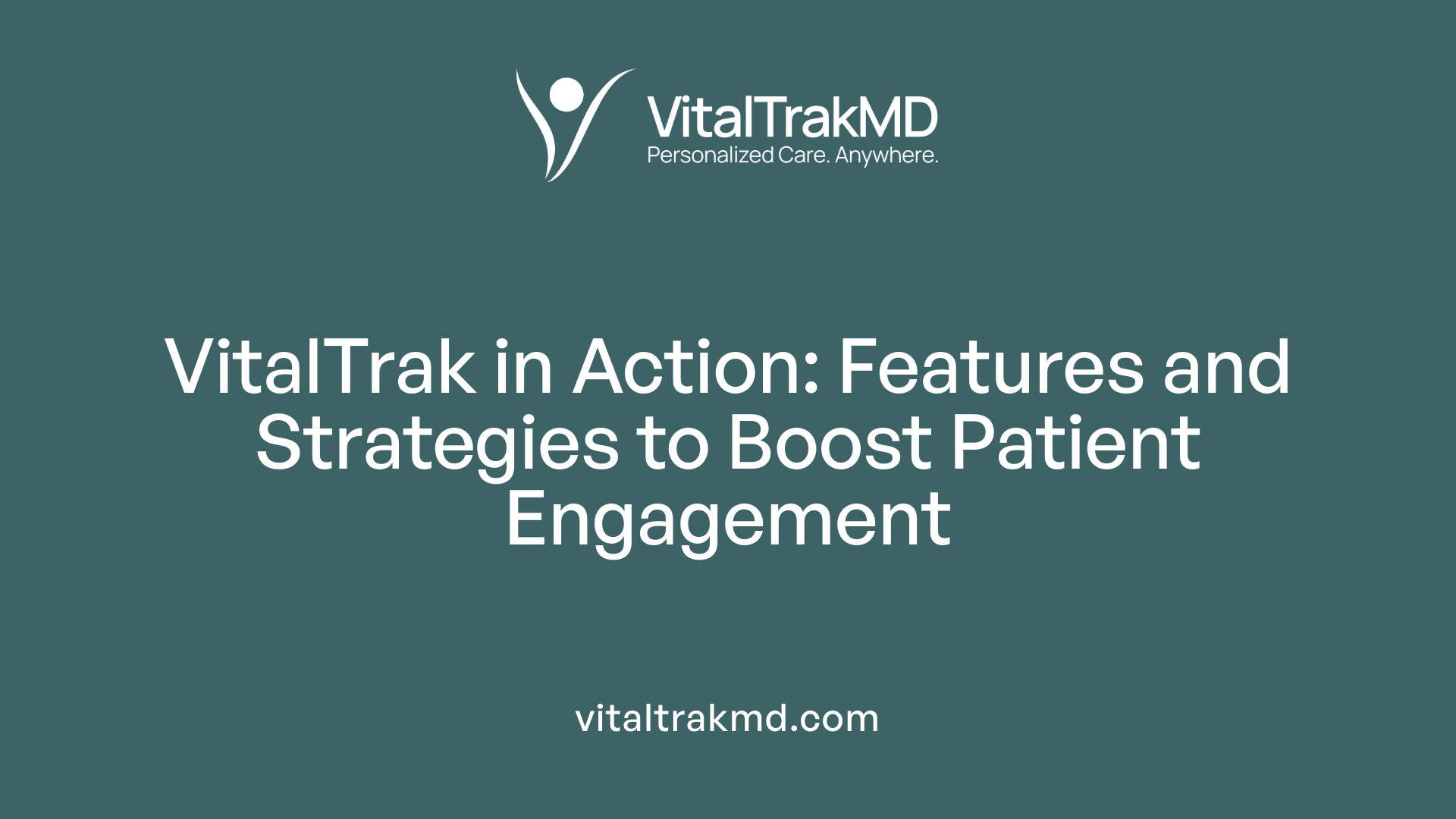
What are VitalTrak's core features?
VitalTrak offers a comprehensive remote patient monitoring platform that supports COPD management through multiple interconnected tools. Its main functions include tracking vital signs like oxygen saturation (SpO2), heart rate (HR), respiratory rate (RR), and lung function via spirometers and biosensors such as the RESP Biosensor. The system allows patients to complete surveys, report symptoms, and track medication adherence. Alerts are generated when parameters breach set thresholds, prompting immediate action by care teams. Additionally, VitalTrak integrates telehealth and pulmonary rehabilitation services, providing real-time data to healthcare providers for proactive intervention. Its predictive analytics leverage AI and machine learning to identify early signs of exacerbation, helping to prevent hospital admissions.
Why is a patient-friendly design important?
VitalTrak is specifically designed with the end-user in mind, ensuring accessibility for seniors and individuals with cognitive impairments. Its intuitive interface and straightforward navigation encourage consistent use and adherence. Devices such as Bluetooth-enabled peak flow meters and wearable monitors are made comfortable and easy to operate, reducing barriers to continuous monitoring. This patient-centric approach increases engagement and empowers individuals to actively participate in managing their COPD.
How does VitalTrak enhance user engagement?
VitalTrak employs multiple tools to foster increased patient involvement. Regular prompts and reminders for medication, symptom tracking, and device measurements support adherence. The platform's messaging feature enables direct communication with care teams, allowing concerns or questions to be addressed promptly. Caregivers and family members can also access vitals and progress reports, creating a supportive environment. Importantly, data visualizations and easy-to-understand reports help patients recognize patterns and understand their condition better, motivating ongoing participation in self-care. Together, these features build a collaborative approach centered on patient empowerment.
| Feature | Description | Benefit |
|---|---|---|
| Remote Vital Monitoring | Blood pressure, oxygen saturation, lung sounds through biosensors | Early detection of exacerbations |
| Automated Alerts | Threshold breaches notify care teams immediately | Prompt interventions |
| Patient Engagement Tools | Surveys, medication reminders, messaging | Increased adherence and awareness |
| Data Integration | Combines population health, chronic, and post-acute care | Comprehensive tracking and decision-making |
| User-Friendly Interface | Designed for seniors and cognitively impaired | High usability |
By combining these functionalities, VitalTrak helps improve COPD outcomes, reduces hospital readmissions, and extends care directly into the home setting—making management more effective and accessible for patients and clinicians alike.
Advances in Home Monitoring Technologies for COPD
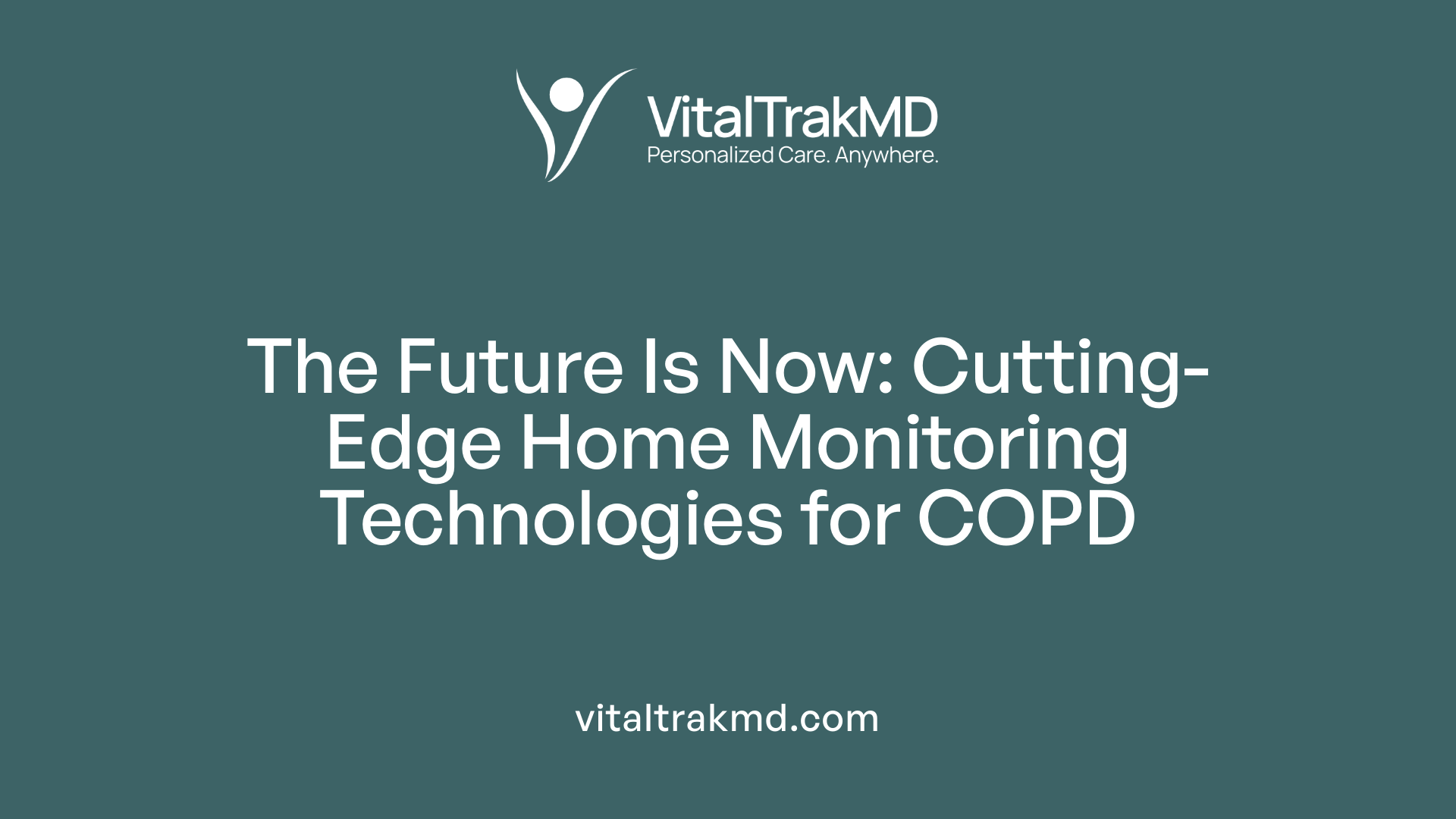
What methods and advancements are available for home monitoring of COPD?
Home monitoring of COPD has seen remarkable progress thanks to modern technologies that enable clinicians and patients to track health status remotely. These advancements include wearable biometric devices, portable spirometers, pulse oximeters, and integrated digital health platforms.
Wearable biometric devices such as wristbands, armbands, vests, and shirts are capable of measuring parameters like respiratory rate (RR), oxygen saturation (SpO2), heart rate (HR), activity levels, and sleep quality. Accurate for early detection of exacerbations, these devices often connect wirelessly to cloud-based systems for real-time data sharing with care teams.
Portable spirometers, like the Bluetooth-enabled Tenovi Peak Flow Meter and the GoSpiro® device, allow patients to measure lung function parameters such as peak expiratory flow (PEF) and FEV1 at home. This data helps detect lung function fluctuations early, aiding medication adjustments and urgent care interventions.
Pulse oximeters, including FDA-cleared models like NoninConnect™, provide continuous or spot checks of blood oxygen levels. Alerts triggered by SpO2 drops below critical thresholds (e.g., 90%) facilitate living safer and more responsive lifestyles.
AI and machine learning (ML) techniques analyze the large datasets collected by these devices. They can predict potential exacerbations and infections, enabling proactive care. For instance, abnormal lung sounds detected by devices like the RESP Biosensor by Strados Labs, which continuously monitors coughs and wheezing, have been linked to hospitalization risk.
In addition to devices, digital health platforms incorporate symptom diaries, electronic questionnaires, and telehealth consultations. These tools create a comprehensive approach to COPD management—empowering patients, improving adherence, and providing clinicians with critical early warning signs.
Research studies demonstrate positive effects, including significant reductions in hospitalizations and improved quality of life. For example, patients using remote monitoring tools showed up to a 65% decrease in hospitalizations over a year.
However, practical considerations like device comfort, patient technological literacy, data security, and integration into existing care workflows remain essential for successful deployment. Ongoing efforts aim to optimize these tools for broader, equitable use.
In summary, the convergence of wearable tech, portable devices, and sophisticated data analysis constitutes a new era in COPD management, making home monitoring more accessible, accurate, and impactful.
| Device Type | Parameters Monitored | Data Security | Notable Features |
|---|---|---|---|
| Wearables | RR, HR, SpO2, activity, sleep | Yes | Continuous data collection, remote alerts |
| Spirometers | Lung function (PEF, FEV1) | Yes | Portable, real-time transmission |
| Pulse Oximeters | Blood oxygen levels | Yes | Spot or continuous checks |
| AI/ML Analysis | Predictive modeling for exacerbations | Integral | Early intervention, personalized care |
By combining these technologies, healthcare providers can offer tailored, timely interventions that significantly enhance disease control and patient quality of life.
Scientific Evidence Supporting Remote Monitoring Effectiveness
Research findings on RPM and wearable devices
Modern remote patient monitoring (RPM) solutions incorporate a range of sensors and devices, such as pulse oximeters, spirometers, and wearable biosensors, to continuously track vital signs and respiratory parameters. These technologies enable real-time data collection, which can be transmitted securely to healthcare providers.
Manufacturers like Strados Labs have developed FDA-cleared devices, such as the RESP Biosensor, that monitor lung sounds like coughing and wheezing, providing early signals of exacerbation risk. Studies have demonstrated that metrics like oxygen saturation (SpO2), respiratory rate (RR), and lung sounds can predict clinical deterioration and potentially prevent hospitalizations.
Impact on hospitalizations and emergency visits
Several studies report significant reductions in healthcare utilization among COPD patients using RPM. For example, research from Pulmonary Associates of Richmond found a 65% decrease in all-cause hospitalizations and a 44.3% decline in emergency department visits after at least a year of remote monitoring. Similarly, Spire Health reports indicate fewer unplanned hospital stays and emergency visits among RPM users.
An integrated digital system utilizing home spirometry, pulse oximetry, and digital questionnaires also reported that 57% of participants experienced noteworthy improvement in COPD symptoms. These findings suggest that early detection of physiological changes allows for faster clinical responses, reducing the need for emergency care.
Benefits of early detection and intervention
The ability to identify early warning signs such as low oxygen levels or abnormal lung sounds enables prompt medical interventions. For instance, blood oxygen levels below 90% can trigger automated alerts for caregiver action, facilitating timely adjustments to treatment plans.
Wearable devices like smartwatches and Bluetooth-enabled peak flow meters support continuous monitoring outside clinical settings, providing patients with actionable feedback and encouraging proactive management. In some cases, physiologic alarms have predicted exacerbations up to 48 hours in advance.
Overall, scientific research underscores that remote COPD monitoring improves disease control, promotes safer medication management, and enhances patient engagement. Although evidence confirms some positive outcomes, variations in study design and quality mean that further high-quality research is necessary to conclusively verify these benefits across diverse patient populations.
| Aspect | Findings | Additional Notes |
|---|---|---|
| Hospitalizations | 65% decrease in all-cause hospitalizations | Based on Pulmonary Associates study |
| Emergency Visits | 44.3% decrease | Spire Health reports |
| Symptom Improvement | 57% experienced symptom score reduction | Digital monitoring study |
| Early Detection | Predictive alarms up to 48 hours before exacerbation | Physiologic alarm data |
| Patient Engagement | High adherence and satisfaction | Study questionnaires |
This body of evidence advocates for integrating RPM devices into routine COPD management, emphasizing early detection, reduced hospital burden, and improved quality of life for patients.
Emerging Devices and Future Directions in COPD Remote Management
Are there emerging remote management options and devices for COPD?
The landscape of COPD management is rapidly evolving with the advent of innovative digital tools and devices designed to enhance patient care outside of traditional clinical settings. Among these innovations are smart inhalers, biosensors, telehealth platforms, and AI-powered alert systems that provide real-time data and support personalized treatment plans.
Smart inhalers equipped with sensors can track inhaler use, ensuring proper technique and adherence. For example, digital inhalers connected via Bluetooth transmit usage data directly to care teams, helping to monitor medication adherence and effectiveness.
Biosensors, such as the FDA-cleared RESP Biosensor, continuously monitor lung sounds like coughing and wheezing. These devices transfer vital data to clinician portals, enabling early detection of exacerbations and timely interventions.
Wearable technology, including smartwatches and respiratory rings, can monitor physiological parameters such as respiratory rate, oxygen saturation, activity levels, and sleep patterns. These continuous observations allow healthcare providers to detect early signs of deterioration and intervene proactively.
Remote patient monitoring systems leverage devices like pulse oximeters, spirometers, and peak flow meters, often integrated into comprehensive platforms like VitalCare. These systems deliver real-time data on lung function and oxygen levels, facilitating early response to fluctuations that could lead to hospitalization.
Artificial intelligence (AI) and machine learning are increasingly applied to analyze collected data. These technologies can predict exacerbation risks by recognizing patterns in physiological signals, enabling earlier treatments and reducing emergency events.
Digital pulmonary rehabilitation programs have demonstrated efficacy comparable to center-based therapies. Telehealth platforms provide supervised exercise regimens, educational resources, and direct communication with health professionals, supporting ongoing patient engagement.
The COVID-19 pandemic has accelerated the adoption of remote management tools, emphasizing the importance of continual, accessible care.
Despite these advances, challenges such as ensuring data security, patient digital literacy, and equitable access remain. Ongoing efforts aim to better integrate these innovations into routine care, expanding their reach to diverse patient populations.
In summary, emerging remote options for COPD include smart inhalers, biosensors, wearable physiological monitors, sophisticated AI alert systems, and virtual pulmonary rehabilitation programs. These advancements collectively offer a future of more personalized, proactive, and accessible disease management, improving patient outcomes and reducing healthcare costs.
Patient Perspectives and Satisfaction with Remote Monitoring Systems
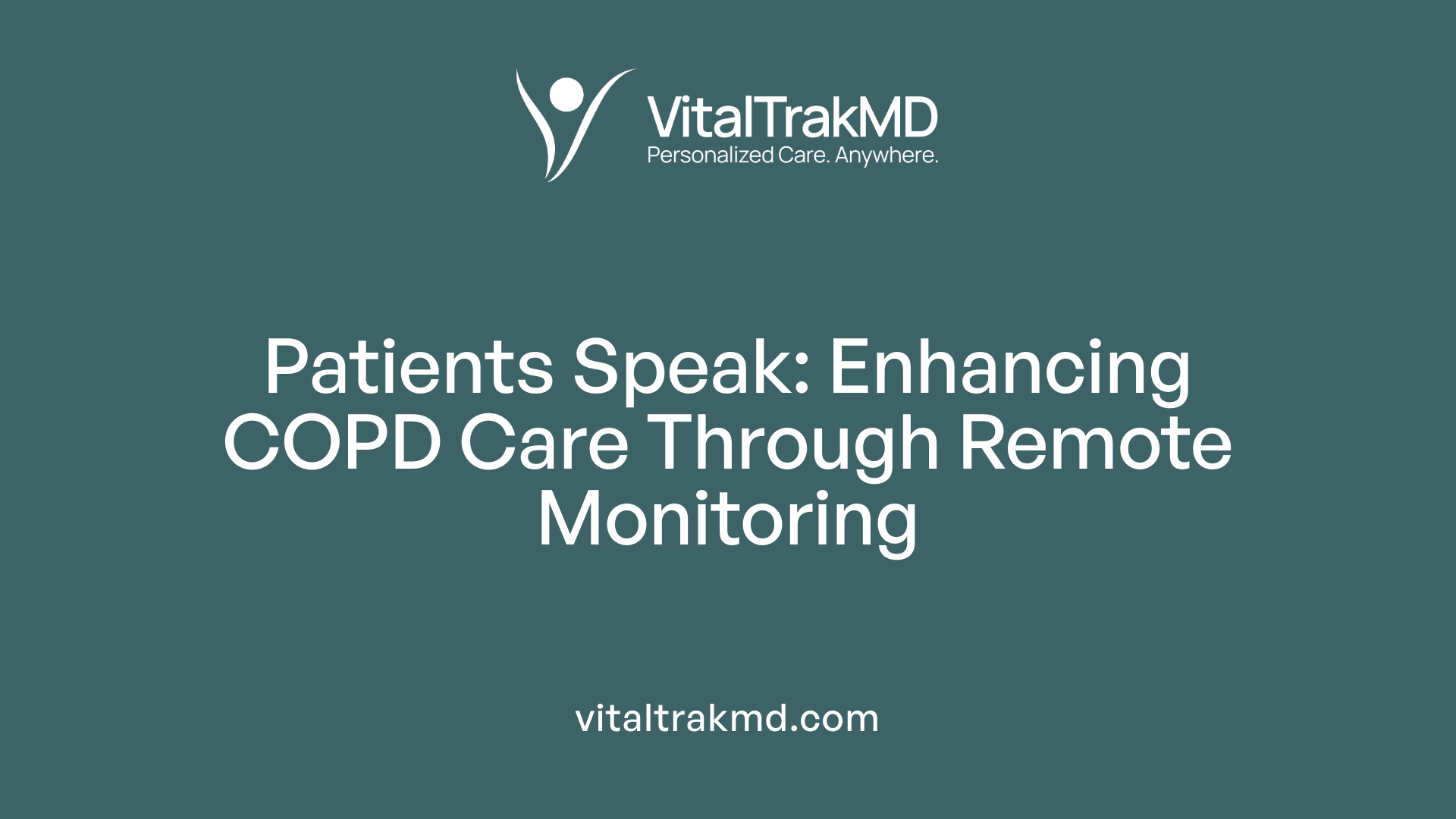
What do patients say about using remote monitoring tools for COPD?
Many COPD patients report a positive experience with remote monitoring systems like VitalCare. They appreciate the ability to track their health parameters at home without frequent clinic visits, making disease management more convenient. Patients often find that being able to complete surveys and monitor their vital signs at their own pace helps them feel more engaged and in control of their condition.
Feedback from users highlights that real-time data sharing with their care teams provides reassurance. Knowing that their health status is continuously monitored helps reduce anxiety about sudden exacerbations. Patients also value the quick alerts received when any health thresholds are breached, which prompts timely medical intervention.
How do patients perceive the security and confidence in these systems?
Patients generally feel confident in the security of remote monitoring platforms like VitalCare. The systems use secure data transmission and privacy protocols, which is reassuring to users concerned about confidentiality. Many report feeling more secure knowing their health data is regularly reviewed by their care team, and they are often encouraged to message clinicians directly if concerns arise.
This level of communication fosters trust, strengthening the patient-care provider relationship. Especially for seniors and cognitively impaired users, the platform’s user-friendly design and support help them feel comfortable using technology to manage their health.
What impact do these systems have on their quality of life?
The shift to remote management significantly improves the overall quality of life for COPD patients. Patients experience increased independence, allowing them to stay at home while maintaining close contact with their healthcare providers. They report feeling more proactive in their health, which improves adherence to treatment plans such as medication reminders.
Studies also show that patients using remote monitoring tools experience fewer hospital visits and better disease control. The psychological benefits, such as feeling safer and less anxious about sudden health issues, further enhance their daily living.
| Aspect | Patient Feedback | Additional Details |
|---|---|---|
| Convenience | Appreciates self-monitoring at home | Reduces travel and clinic visits |
| Confidence in Technology | Feels secure with data privacy | User-friendly interfaces assist seniors |
| Quality of Life | Sees fewer hospitalizations, peace of mind | Increased independence and engagement |
In essence, patients value the adaptability, security, and positive health outcomes provided by remote monitoring systems like VitalCare. Their experiences highlight the importance of designing patient-centered tools that enhance confidence and support healthier living.
Challenges and Considerations in Implementing Remote Monitoring for COPD
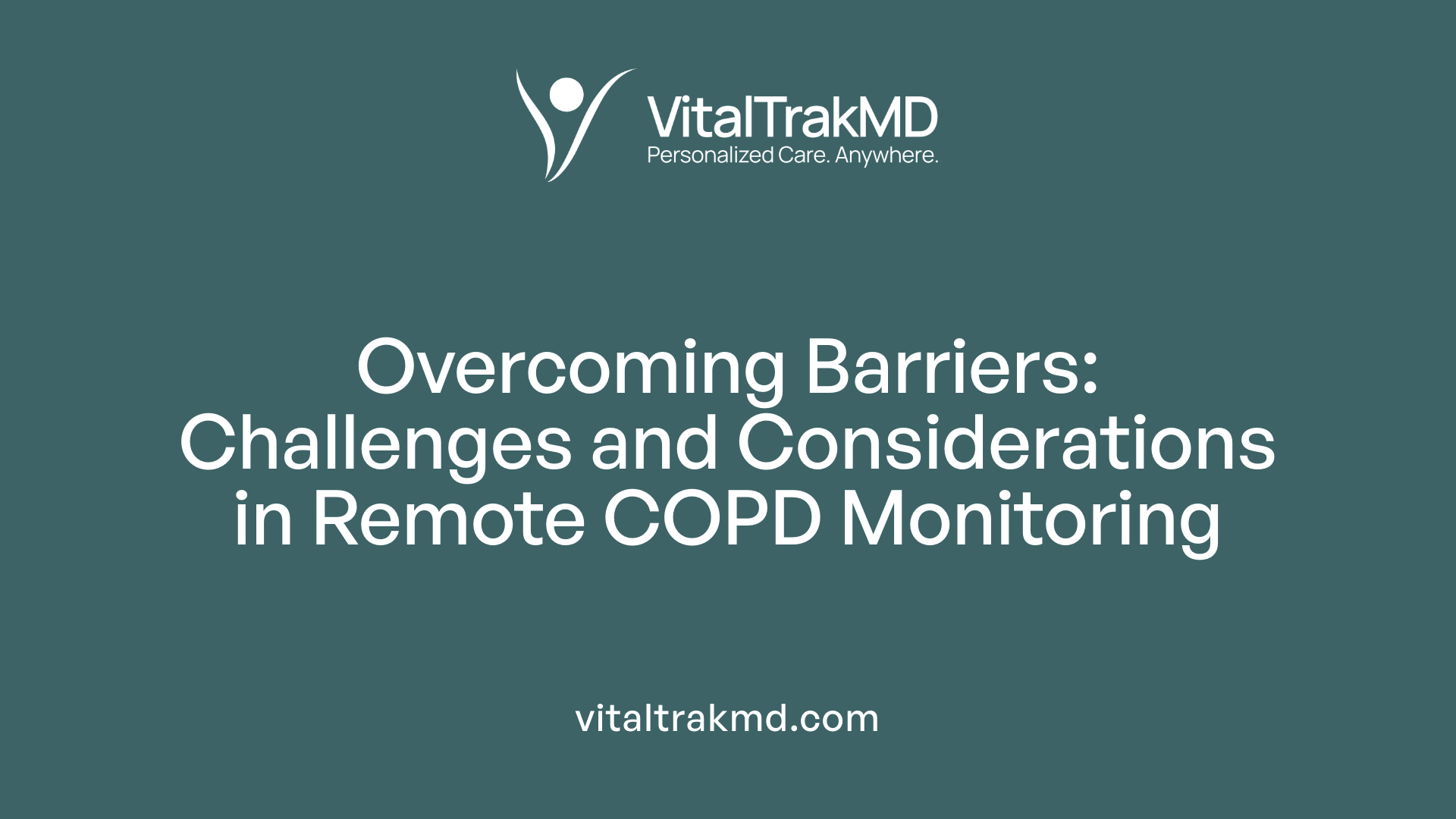
Data security and privacy
Implementing remote patient monitoring (RPM) solutions like VitalCare requires careful handling of sensitive health data. Ensuring that patient information remains confidential and protected against cyber threats is critical. Secure encryption protocols and compliance with health data regulations, such as HIPAA, are essential to maintain trust and legal standing.
Technological literacy and accessibility
While devices like wearables and digital questionnaires significantly enhance COPD management, their effectiveness depends on patients' ability to use them comfortably. Older adults or those with cognitive impairments may face challenges in navigating new technologies. VitalCare addresses this by designing user-friendly interfaces and providing support, but ongoing education and personalized assistance are vital.
Integration into healthcare systems
For RPM systems to deliver optimal benefits, they must seamlessly integrate with existing healthcare infrastructure. This includes electronic health records, clinician workflows, and communication channels. Proper integration reduces redundancy, enhances real-time data access, and ensures responsiveness to alerts, ultimately improving patient outcomes.
Cost-effectiveness and policy considerations
Adopting remote monitoring involves upfront investment in devices and technology. While studies indicate that RPM can lower hospital readmissions and overall healthcare costs, policymakers need to evaluate reimbursement models and establish clear guidelines. Supporting policies can facilitate wider adoption, ensuring sustainable implementation across diverse healthcare settings.
| Challenge | Aspect | Impact | Solutions |
|---|---|---|---|
| Data security and privacy | Data protection | Prevents breaches, maintains patient trust | Use encryption, comply with regulations |
| Technological literacy | User-friendliness | Increases patient engagement and adherence | Simplified interfaces, training programs |
| System integration | EHR compatibility | Enables efficient workflow, timely alerts | Standardized data formats, IT support |
| Cost and policy | Funding and reimbursement | Ensures sustainability | Policy advocacy, insurance coverage |
By addressing these challenges, healthcare providers can optimize remote COPD management strategies, leading to better patient care and resource utilization.
The Future Landscape of COPD Management with Digital Health Tools
Integration of Innovations
Advancements in digital health have significantly transformed the way COPD is managed. Tools like VitalCare's platform exemplify how remote patient monitoring (RPM) integrates multiple care modalities, including telehealth, chronic care, and population health in one user-friendly system. Devices such as Bluetooth-enabled spirometers and pulse oximeters transmit real-time data, making it easier for clinicians to monitor lung function, oxygen levels, and symptoms from afar. Studies demonstrate that these innovations can lead to fewer hospitalizations and enhanced disease control.
Personalized Medicine and Artificial Intelligence
The rise of artificial intelligence (AI) and machine learning (ML) is propelling COPD care towards more personalized strategies. RPM data from wearable biosensors and patient-reported surveys are analyzed using AI algorithms to predict exacerbations before they occur. For instance, early warning signals based on abnormal lung sounds or drops in blood oxygen levels facilitate timely interventions, potentially preventing hospital admissions. These predictive analytics support tailored treatment plans, improving patient outcomes.
Enhanced Patient Engagement and Outcomes
Digital health solutions empower patients to take an active role in their care. Patients can self-monitor vital signs, manage medications with reminders, and communicate effortlessly with their care teams via secure messaging and questionnaires. Such features increase adherence to treatment, encourage healthier lifestyles, and boost patient confidence. Clinical studies show that engaging COPD patients through wearable devices and remote monitoring leads to better symptom control, higher satisfaction, and a sense of security.
| Innovation | Impact | Details |
|---|---|---|
| Remote pulmonary tests | Early detection of exacerbations | Devices like peak flow meters transmit data securely to clinicians |
| Wearable biosensors | Continuous lung sound monitoring | The RESP Biosensor detects abnormal lung sounds linked to hospitalizations |
| AI/ML predictive models | Proactive care management | Algorithms analyze physiological data for early interventions |
| Patient portals | Improved communication | Patients message care teams and access health info anytime |
This evolving landscape signals a shift towards more proactive, precise, and patient-centered COPD care, leveraging technology to improve lives.
Summary and Key Takeaways: The Shift Toward Digital COPD Care
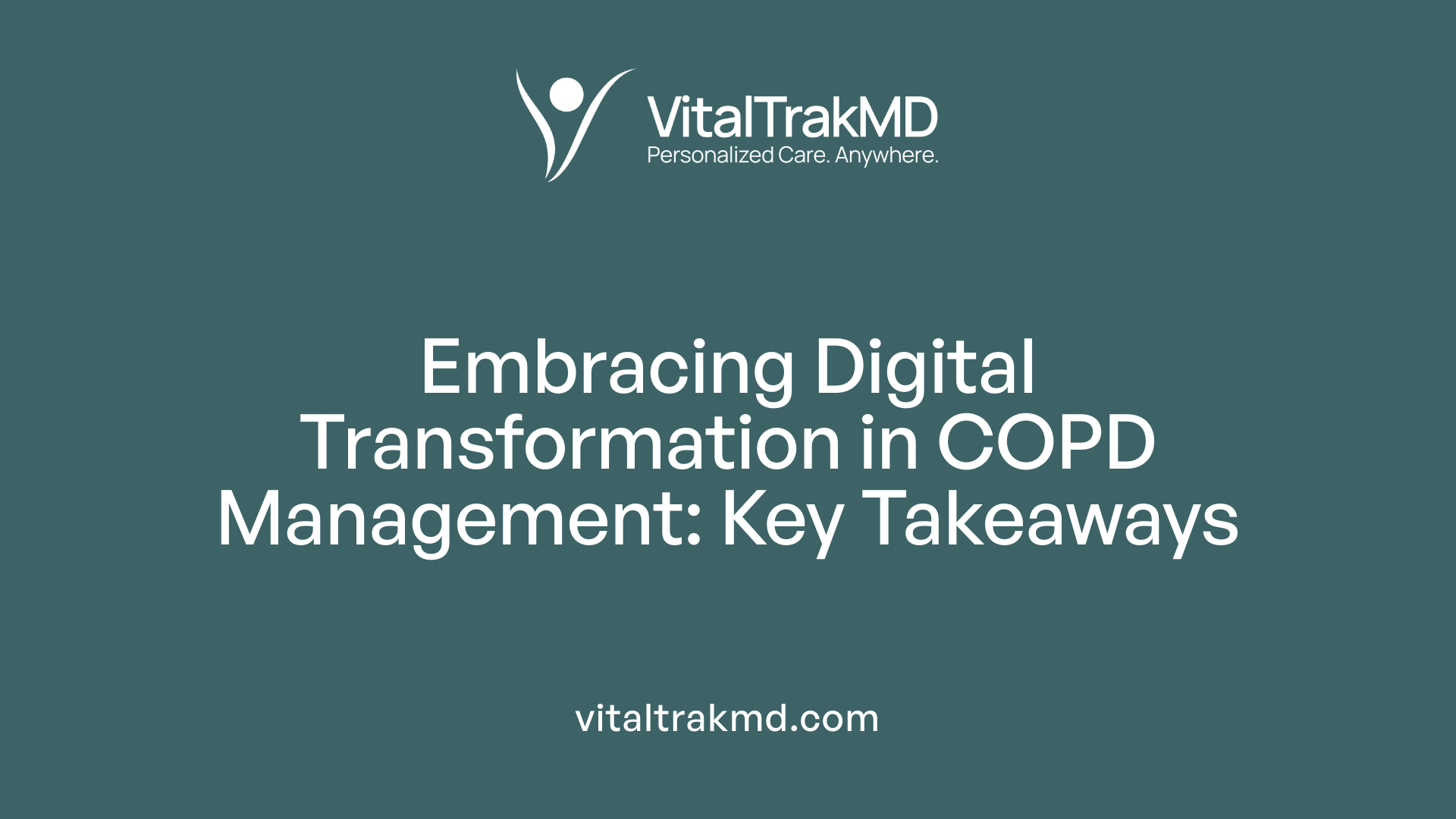
Recap of technological benefits
Emerging digital health solutions like remote patient monitoring (RPM) and wearable technology have revolutionized COPD management. These tools enable continuous tracking of vital signs, lung function, and symptoms from home, reducing the need for frequent in-person visits. Devices such as pulse oximeters, spirometers, and smartwatches deliver real-time data to care teams, allowing for early detection of exacerbations and timely interventions. Studies highlight significant reductions in hospitalizations and emergency visits, demonstrating how technology improves disease control and patient outcomes.
The importance of patient-centered solutions
Platforms like VitalCare emphasize user-friendly interfaces designed to meet diverse patient needs, including seniors and those with cognitive impairments. Features such as medication reminders, secure messaging, and educational resources promote adherence and engagement. By supporting communication and self-management, these solutions empower patients to take an active role in their health, which is crucial for chronic disease management.
The need for ongoing research and development
While current technologies offer promising results, continuous research is essential to refine these tools. Challenges like device comfort, data security, and equitable access must be addressed to maximize benefits. Innovations like AI and machine learning are advancing predictive analytics, potentially enabling preemptive care. Ongoing studies, including community-based interventions and device validation, will help incorporate new insights into clinical practice, ultimately leading to more personalized and effective COPD care.
| Aspect | Details | Additional Notes |
|---|---|---|
| Technologies Used | RPM devices, wearables, telehealth platforms | Improved early detection and management |
| Patient Benefits | Better disease control, higher engagement | Focus on usability for seniors |
| Clinical Impact | Fewer hospitalizations, enhanced quality of life | Supported by recent studies |
| Future Directions | AI, predictive analytics, inclusive designs | Addressing technology barriers |
Advancing digital health tools play a crucial role in transforming COPD care, making it more proactive, patient-centered, and efficient.
Moving Forward with Digital Health in COPD Care
The integration of remote monitoring technologies like VitalTrak signifies a pivotal shift in COPD management, emphasizing proactive, personalized, and accessible care. Continued innovation, research, and policy development will be essential to overcome existing barriers and maximize the potential of digital health tools to improve patient outcomes and reduce healthcare costs, ultimately transforming the landscape of chronic disease management.
References
- VitalCare for COPD - VitalTech
- Remote patient monitoring strategies and wearable technology in ...
- How COPD Remote Patient Monitoring is Improving Patient Outcomes
- Healthy at home for COPD: an integrated digital monitoring ...
- Home Monitoring in COPD | Journal of COPD Foundation
- COPD Remote Patient Monitoring: Overview & New Technologies
- COPD Remote Patient Monitoring: Overview & New Technologies
Recent articles
Want to Feel Better and Live Healthier?
Join hundreds of patients taking control of their health with personalized care that fits their life – not the other way around.
Rated 4.8/5 by 32+ customers







